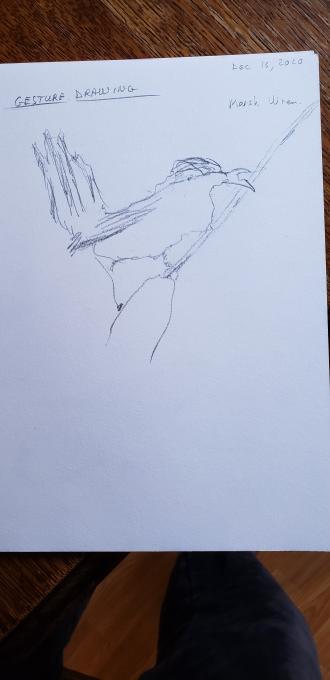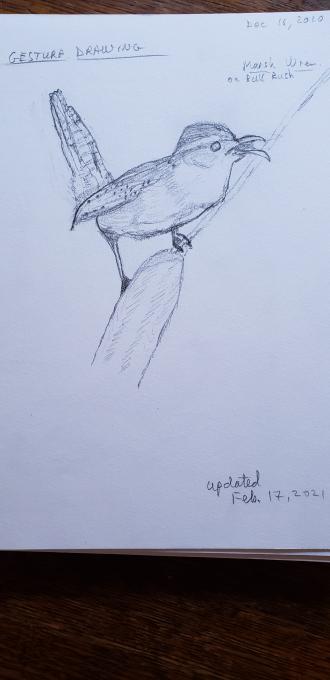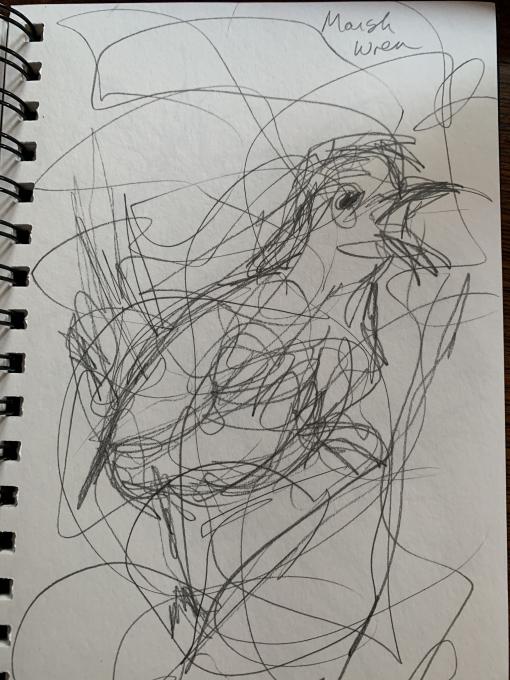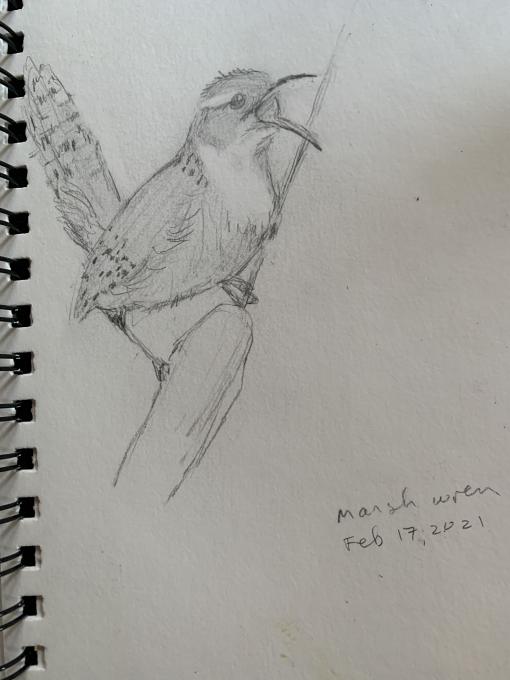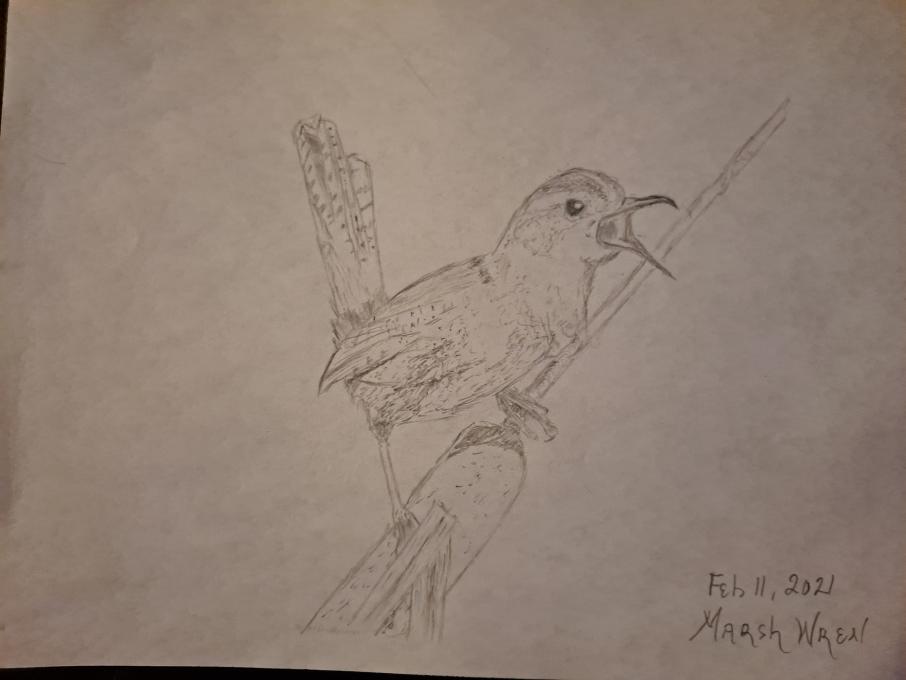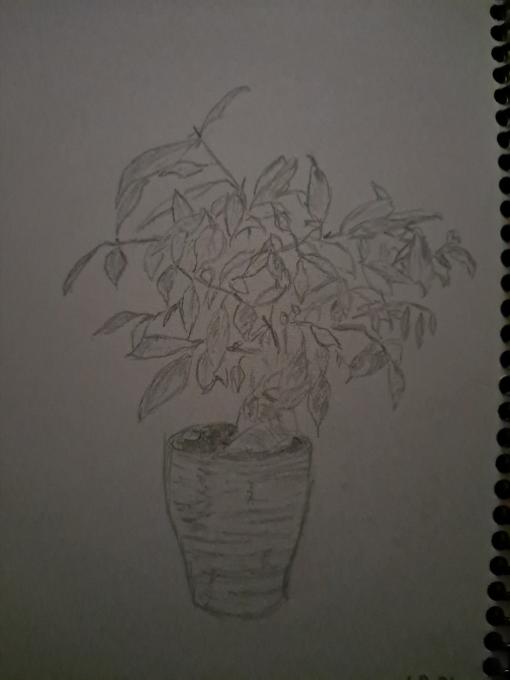The Cornell Lab Bird Academy › Discussion Groups › Nature Journaling and Field Sketching › Giving Your Drawings Depth
-

-
 It is tough to be in the field and trying for the full gesture drawing before the subject leaves. The Cedar Waxwing flew in a blink but in that moment, I could not see the flat shape of the top of its head. The feathers seemed tucked down as it flew. Does anyone know why this bird has a red spot on the tertial feathers? What adaptation could the red color be for and in only one small spot?
It is tough to be in the field and trying for the full gesture drawing before the subject leaves. The Cedar Waxwing flew in a blink but in that moment, I could not see the flat shape of the top of its head. The feathers seemed tucked down as it flew. Does anyone know why this bird has a red spot on the tertial feathers? What adaptation could the red color be for and in only one small spot? -
I continue to battle proportions in my viewpoints but feel better at observation details. Short strokes help a lot. Always willing to walk away from the drawing and then come back to refine again and again.

-
Still sometimes dealing with proportion of viewpoint. Sketchy lines approach has helped me over the course rather than just aiming for shapes. Still working on the details always...
-
Gesture Drawing Exercise: Not much detail just a basic outline, I didn't really get in any shading and proportions of parts are all wrong.
 Refined Drawing: I was able to add a lot more details to this drawing. I had to do a lot of fixing of proportions and shading of light and darks. The proportions still need work I think, there are still more details that I overlooked when I took a step back at my drawing. It was fun though!
Refined Drawing: I was able to add a lot more details to this drawing. I had to do a lot of fixing of proportions and shading of light and darks. The proportions still need work I think, there are still more details that I overlooked when I took a step back at my drawing. It was fun though!

-
I have learned more about balancing proportion. Looking back at my sketches I can see where measuring makes a huge difference. Blank space has made a difference

-
I am pleased with my progress, knowing that I will never be an artist. All the skills have been useful to me. I taught biology and zoology and always told my students I flunked art. I think noticing the open spaces has been very helpful.
-
Took a quick sketch image and tried to make it better.

-
 I’m happy with this. But there was a lot of rubbing out !! 🙄
I’m happy with this. But there was a lot of rubbing out !! 🙄 -
The points I jotted down about drawing skills helped a lot to do this drawing. I felt more confident when I started drawing. Using sketchy lines made it easy to depict subjects on paper. Looking at negative space is more naturally now. The challenging aspect of the drawing was the proportion/ Yet. by measuring techniques it became more easy. Looking at negative space helped so much.

-
The proportions were so wrong on my gesture drawing that I ended up nearly redoing the entire drawing. Looking at negative space really helps.
-


-
 I think looking at the negative space has been the most helpful. It's something I didn't think about before but it has really helped me get my proportions more accurate.
I think looking at the negative space has been the most helpful. It's something I didn't think about before but it has really helped me get my proportions more accurate.
-
I feel like I still need to work on shading to create depth and contrast. I think putting in more hours would help! I found the squint test to be the most helpful. I'd never really thought about using a technique like that to see the lights and darks when drawing.


-
Looking at negative spaces has probably made the biggest impact in my drawing. I think switching to a harder lead may help (currently using 0.5 mm HB .. may switch to an "F" or an "H"). BEFORE:
 AFTER:
AFTER:

-
 Still too afraid to lean in on the picture.
Still too afraid to lean in on the picture. -
When creating depth I find that concentrating on negative space, and shapes is really important . However, shading with the side of my pencil the way that I would do in “chiaroscuro” exercise works best for me. So I always lean on that technique. I find hatching and cross hatching very difficult even though I like the look in drawings . I guess it’s something I really need to practice to add variety. I recently tried using a pencil or small ruler to judge proportion . I’ll carry a ruler along in my art tote now. I use to guess for my proportions.
-

-
I found this difficult to draw . Honestly , I had to keep referring back to the video . I caught a fragment at a time in order to complete the drawing. The moving feather details were hard to follow. I tried to capture as much as I could . This duck is only shades of gray but the feathers are really awesome in action.
-
-

-


-
So much harder than it looks, but so fun to draw
-
-
 I enjoyed this! I found myself thinking about the similarities of this bird to the Carolina wren - a bird I see often in my bird feeding area. It's one of my favorite birds because of its overall delicacy, perky tail and rich rust coloring.
I enjoyed this! I found myself thinking about the similarities of this bird to the Carolina wren - a bird I see often in my bird feeding area. It's one of my favorite birds because of its overall delicacy, perky tail and rich rust coloring. -
Your drawing is really great! I like how you made the feather texture look so soft.
-
-
Feels like a complete make over... lots of erasing...and the bill...and I have gotten to know the marsh wren a lot better...fun! b


-
My gesture drawing was a bit of a wild exploration. Today's drawing more controlled. I still didn't 'get it', but it's fun to try!


-
Proportions seems a bit of a challenge in my sketching. The challenge lies not solely in measurement, but more in that when as adjustments are made to correct, other areas and angles begin to be thrown off. Here are a couple that I got mostly correct.


-
I tend to want to draw in sections and I need to remember to try and focus on the shapes and then refine from there. the negative space and proportion skills are so useful but I always get deep into the drawing before I realize I forgot to use them. all of these tool have really been helpful!
Read More:

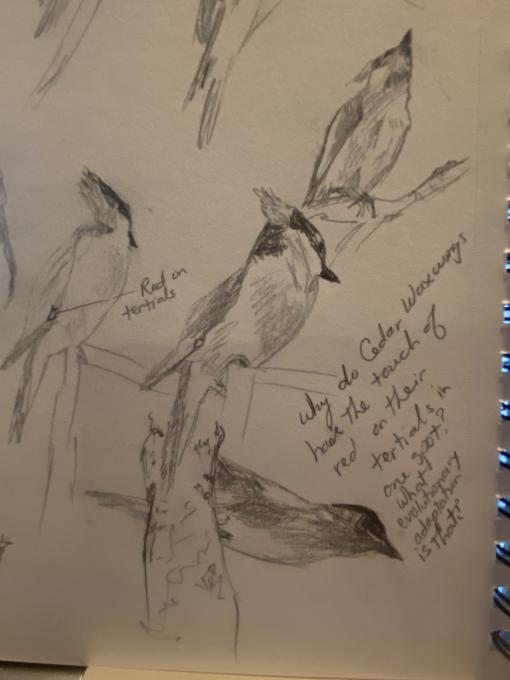 It is tough to be in the field and trying for the full gesture drawing before the subject leaves. The Cedar Waxwing flew in a blink but in that moment, I could not see the flat shape of the top of its head. The feathers seemed tucked down as it flew. Does anyone know why this bird has a red spot on the tertial feathers? What adaptation could the red color be for and in only one small spot?
It is tough to be in the field and trying for the full gesture drawing before the subject leaves. The Cedar Waxwing flew in a blink but in that moment, I could not see the flat shape of the top of its head. The feathers seemed tucked down as it flew. Does anyone know why this bird has a red spot on the tertial feathers? What adaptation could the red color be for and in only one small spot? 
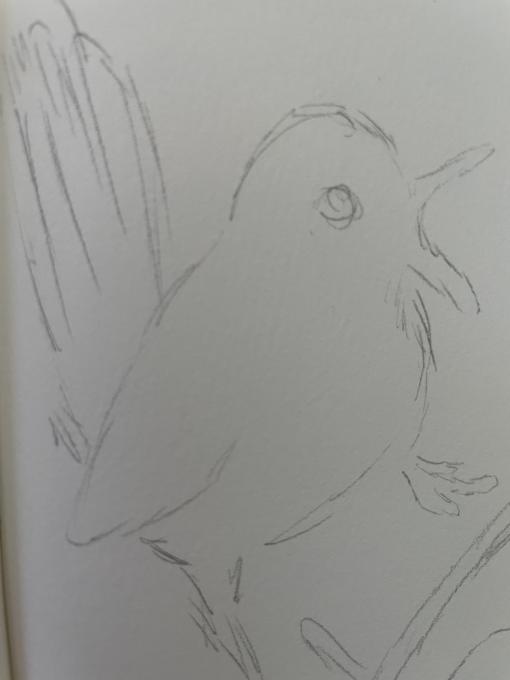 Refined Drawing: I was able to add a lot more details to this drawing. I had to do a lot of fixing of proportions and shading of light and darks. The proportions still need work I think, there are still more details that I overlooked when I took a step back at my drawing. It was fun though!
Refined Drawing: I was able to add a lot more details to this drawing. I had to do a lot of fixing of proportions and shading of light and darks. The proportions still need work I think, there are still more details that I overlooked when I took a step back at my drawing. It was fun though!
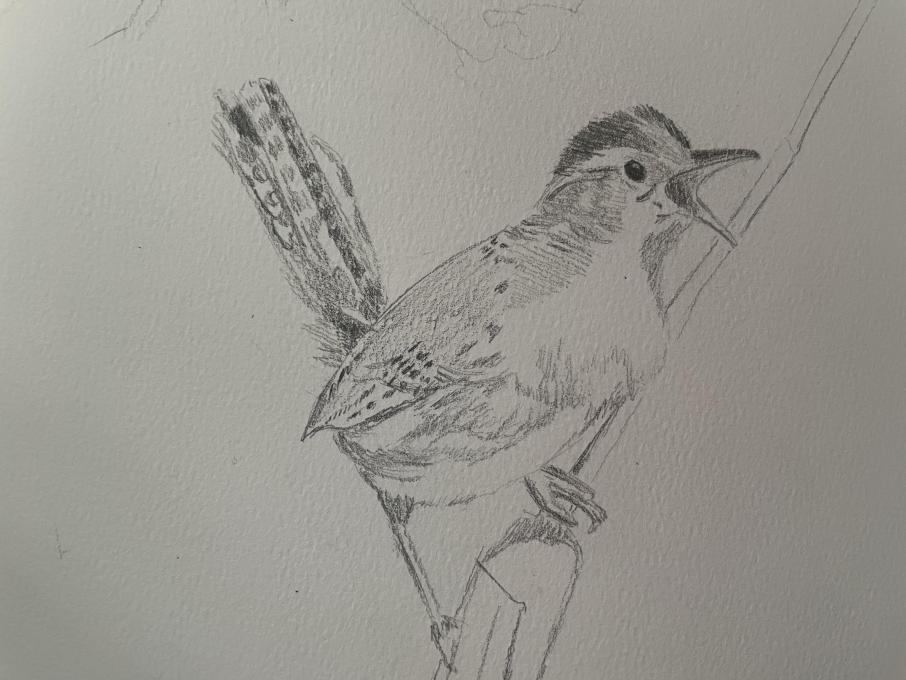


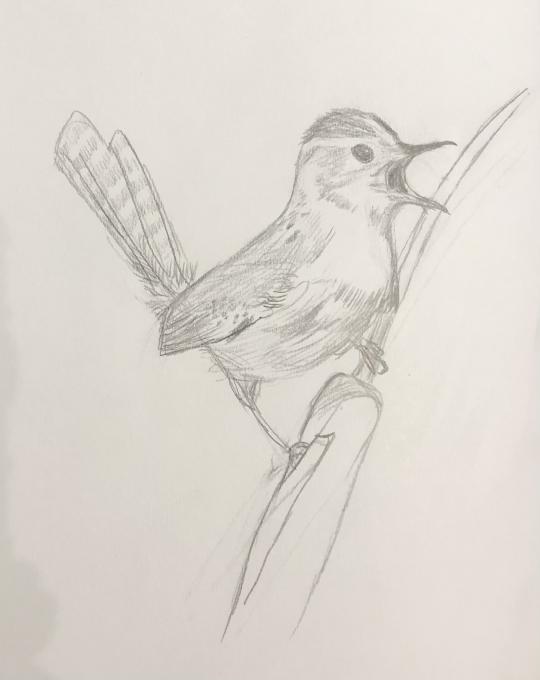 I’m happy with this. But there was a lot of rubbing out !! 🙄
I’m happy with this. But there was a lot of rubbing out !! 🙄 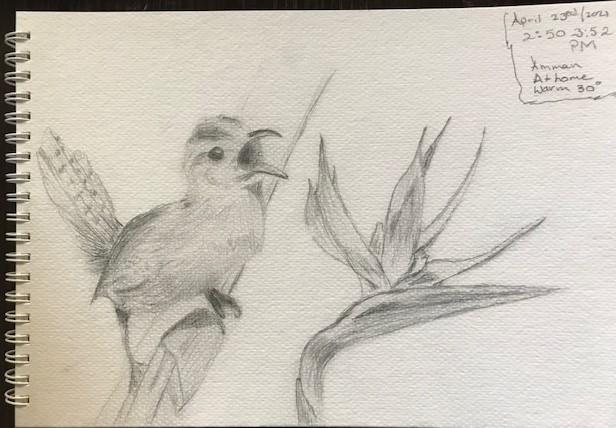
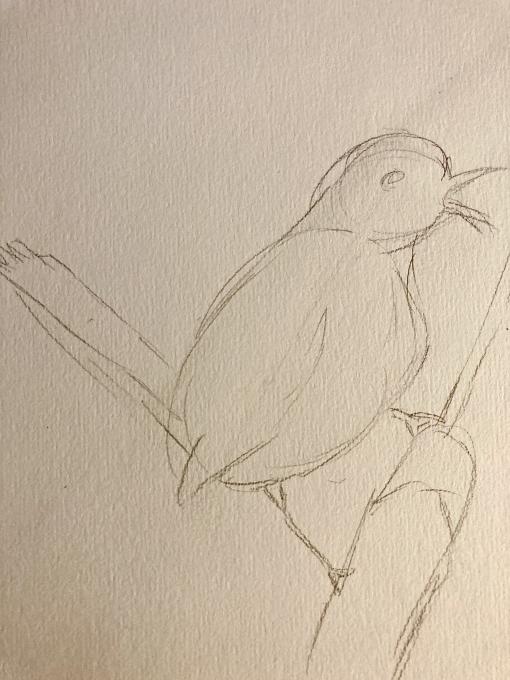
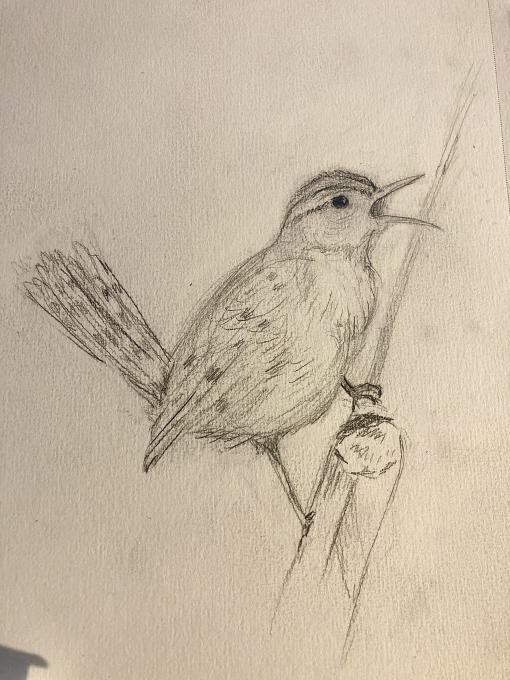
 I think looking at the negative space has been the most helpful. It's something I didn't think about before but it has really helped me get my proportions more accurate.
I think looking at the negative space has been the most helpful. It's something I didn't think about before but it has really helped me get my proportions more accurate.
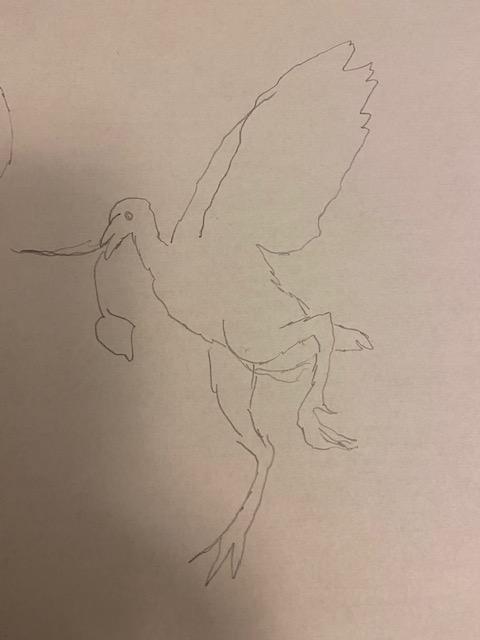
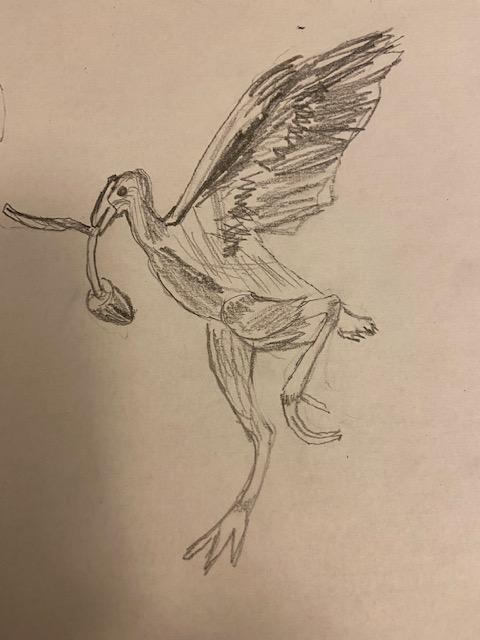
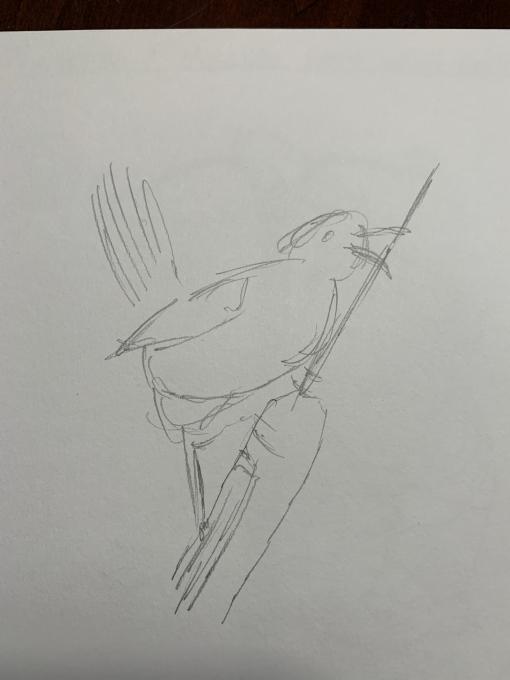 AFTER:
AFTER:

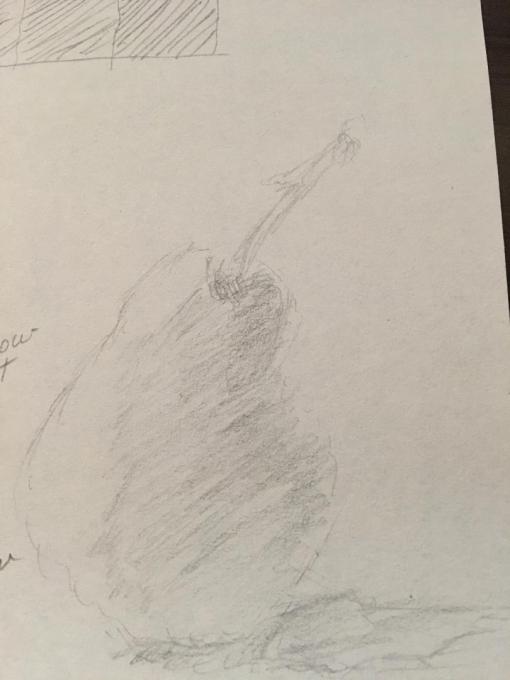 Still too afraid to lean in on the picture.
Still too afraid to lean in on the picture. 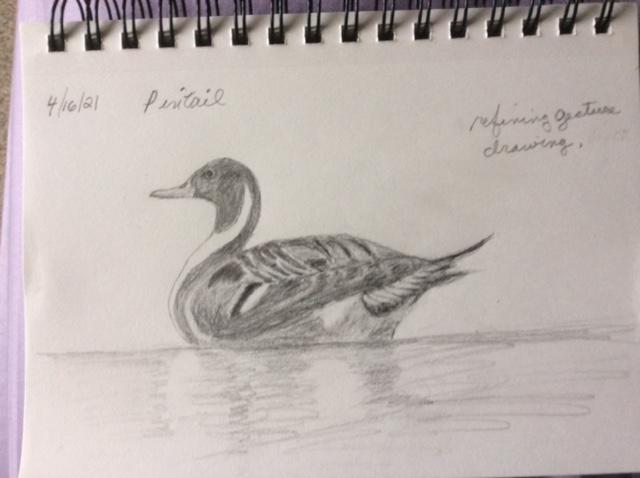
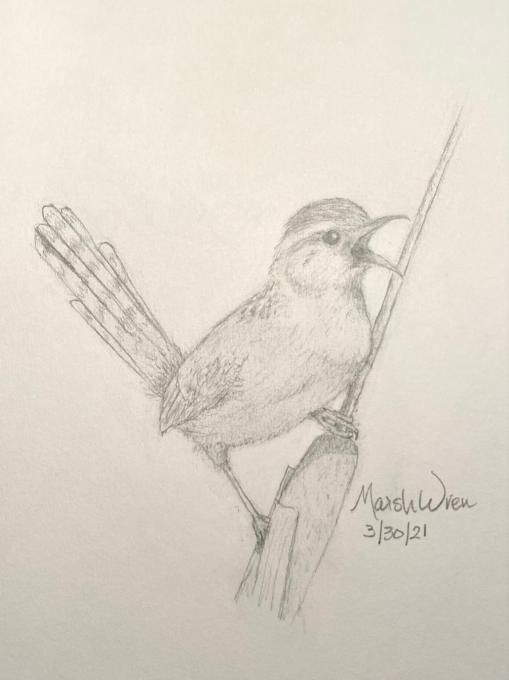
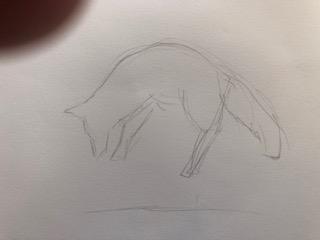

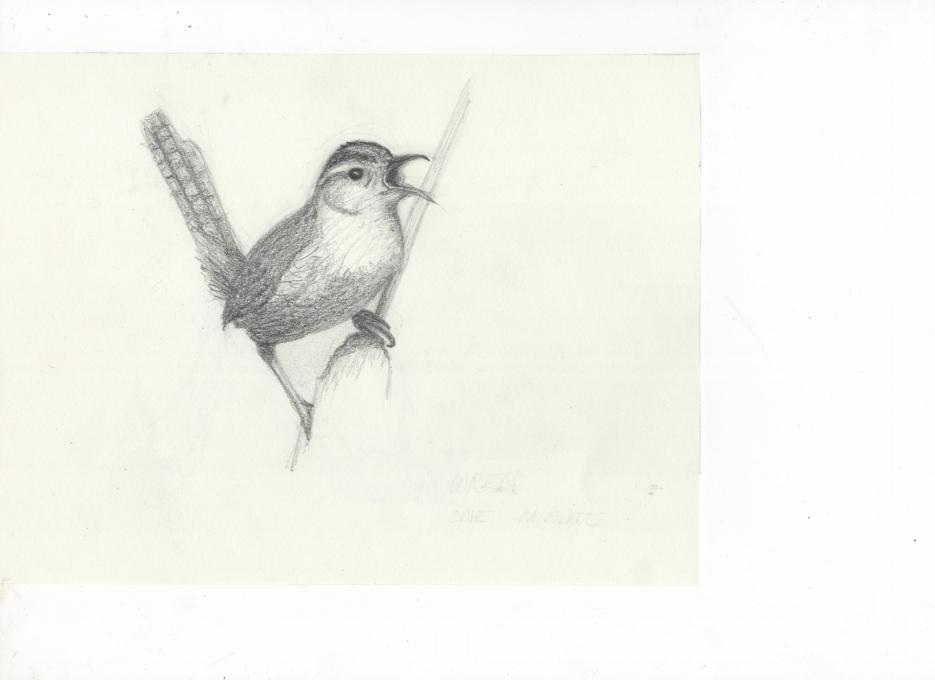 I enjoyed this! I found myself thinking about the similarities of this bird to the Carolina wren - a bird I see often in my bird feeding area. It's one of my favorite birds because of its overall delicacy, perky tail and rich rust coloring.
I enjoyed this! I found myself thinking about the similarities of this bird to the Carolina wren - a bird I see often in my bird feeding area. It's one of my favorite birds because of its overall delicacy, perky tail and rich rust coloring. 